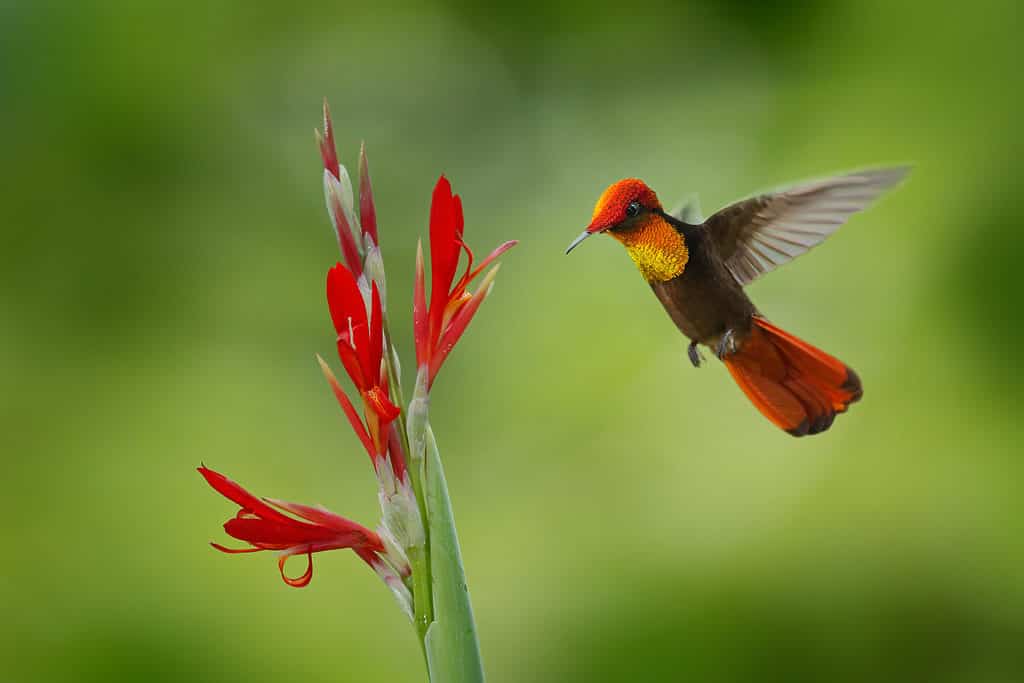Trinidad and Tobago is a beautiful Caribbean island country near Venezuela. The island’s culture is vibrant and full of life, reflected in its official flag. The flag and the country’s coat of arms have a lot of meaning and symbolism. Keep reading to learn more about Trinidad and Tobago’s national flag.
Where Is Trinidad And Tobago Located On The Map?
Trinidad and Tobago is located off the mainland of South America, 81 miles south of Grenada and about 6.8 miles away from the coast of Venezuela. This country has two main islands, Trinidad and Tobago, with multiple smaller islands. It’s also the most southern island country in the Caribbean. The country is also on the West Indian Island chain, which separates the Atlantic Ocean and the Caribbean Sea.
What Animals Live In Trinidad And Tobago?
The animals of Trinidad and Tobago include over 950 fish species, 100 species of mammals, and 90 types of reptiles.
A Brief History Of Trinidad And Tobago

Trinidad and Tobago are part of the Caribbean Islands.
©Pyty/Shutterstock.com
Trinidad and Tobago’s history is rich. For the sake of the article, we will only give a brief history of the country. Its history begins with the indigenous people of Trinidad and Tobago. These islands were the earliest settled part of the Caribbean. At least 7,000 years ago, indigenous people from South America traveled to the islands.
European Colonization And Rule
Christopher Columbus was the first European to set their eyes on Trinidad in 1498. While he didn’t immediately set foot on the island, he called it Bellaforma. It wasn’t until the 1530s when Spanish soldiers landed on the island, planning to conquer its indigenous people. They fought multiple times, and the Spanish built a fort. After decades of brutal fighting, the chief, Wannawanare, moved his people to another part of the country, giving modern-day Saint Joseph to the Spanish. During the 1600s and 1700s, many European powers like the Dutch, Spanish, and Couronians attempted to colonize the country. They were primarily unsuccessful but settled in a small part of Tobago and funded a plantation. They brought over enslaved Africans; eventually, there were more enslaved people than European colonizers.
In Tobago, rulers changed frequently. The island’s rulers changed 31 times before 1814. The British, for example, held rule over Tobago from 1762 to 1781 and again after 1793. While this was occurring, the Spanish funded catholic missions to Trinidad to convert indigenous people. A lot of violence arose because of this practice and encomienda, which resulted in the San Rafael encomienda rebellion. Indigenous people killed the Spanish governor and multiple priests. The Spanish retaliated with more violence, known as the Arena massacre.
French settlers came to Trinidad starting in 1777 when free trade was allowed. In just five years, the Port of Spain’s population jumped from 3,000 to 10,422. Britain ruled Trinidad beginning in 1802. Many European settlers came to the island. When slaves were emancipated, indentured servants from India and China came to the island to work on plantations.
Independence
Trinidad and Tobago sought independence on its own. The country officially gained its independence from the U.K. in 1962. However, Elizabeth II remained queen. Eric Williams, an important community member, and historian, was the country’s first prime minister. As the civil rights movement in the U.S. was booming, the Black Power movement arose in Trinidad and Tobago.
The Flag of Trinidad and Tobago

The country adopted the official flag of Trinidad and Tobago in 1962.
©Momcilica/Shutterstock.com
Trinidad and Tobago’s flag may look simple, but it holds a lot of meaning and pride. The flag of Trinidad and Tobago features a bright red field with a black diagonal band across the flag, starting from the upper left corner. The diagonal band is outlined with a white edge. It was officially adopted as the flag on August 31, 1962. Artist Carlisle Chang designed Trinidad and Tobago’s flag. The flag symbolizes fire, earth, and water. Fire represents courage, while earth represents dedication. Finally, water symbolizes purity and equality. Before this most recent flag was adopted, Trinidad and Tobago used a British colonial flag. The flag had a British blue ensign with a small badge on the lower right of the flag. The badge depicted a ship arriving in front of a mountain.
Trinidad and Tobago’s Coat of Arms

The ruby topaz is one of 18 species of hummingbirds in Trinidad and Tobago.
©Ondrej Prosicky/Shutterstock.com
The coat of arms is more complex, with a unique design and multiple colors. A committee, including influential designers like Carlisle Chang and George Bailey, designed Trinidad and Tobago’s coat of arms. It was officially adopted in 1962. The coat of arms has a palm tree crest at the top. The red, black, and white shield holds the flag’s meaning. There are also three gold ships on the shield, representing the ships Christopher Columbus used on his voyage.
There are also two golden hummingbirds facing each other on the shield. This is a nod to Trinidad, as it’s the nickname of the island. Trinidad has about 18 recorded species of hummingbirds. On each side of the coat of arms are two other birds. The Scarlet Ibis is on the left and is the national bird of Trinidad. The Cocrico is Tobago’s national bird.
Underneath the shield are three green hills representing the Trinity Hills in southern Trinidad. Under the Cocrico is the island of Tobago, rising from the water. Lastly, the nation’s motto, “Together We Aspire, Together We Achieve,” is on a large golden ribbon at the bottom of the coat of arms.
The photo featured at the top of this post is © Momcilica/Shutterstock.com
Thank you for reading! Have some feedback for us? Contact the AZ Animals editorial team.







